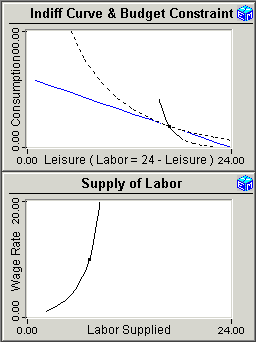Will a tax cut induce people to work more?
This issue can be addressed within the context of a model of labor supply. In particular, a model of utility maximizing agents facing what is known as the labor-leisure tradeoff is particularly appropriate. This EconModel application considers both a percentage income tax and a fixed dollar tax or rebate.
![]() Model Link:
Labor Supply,
Model Link:
Labor Supply,
Income Taxes, and Transfer Payments
<activate
the model links>
Printable PDF Exercises
 The labor-leisure tradeoff is based on a utility function that depends
on two goods, consumption and leisure. This application analyzes
two utility functions:
The labor-leisure tradeoff is based on a utility function that depends
on two goods, consumption and leisure. This application analyzes
two utility functions:
- Cobb-Douglas Utility
- "Real World" Utility
For either utility function, you can draw indifference curves and a budget constraint. Repeating this process for range of wage rates allows you to:
- Derive the Supply of Labor
- Analyze the Effects of Income Taxes
- Analyze the Effects of Transfer Payments
Under certain conditions, you obtain the famous Backward-Bending Labor Supply Curve that shows labor supplied decreasing as the wage rate increases.
Classic Economic Models
Microeconomics
Introduction
Overview of Micro Models
Supply and Demand
Basic Supply and Demand
Who Pays a Sales Tax?
The Cobweb Model and
Inventory-Based Pricing
Theory of the Firm
Perfect Competition
Monopoly and
Monopolistic Competition
Price Discrimination
The Demand for Labor
Theory of the Consumer
Two Goods - Two Prices
Intertemporal Substitution
Labor Supply, Income Taxes,
and Transfer Payments
Macroeconomics
Introduction
Overview of Macro Models
Models in Chronological Order
The Classical Model
The Simple Keynesian Model
The Keynesian IS/LM Model
The Mundell-Fleming Model
Real Business Cycles
The IS/MP Model
The Solow Growth Model
Financial Markets
Utility-Based Valuation of Risk
Mean-Variance Analysis:
Risk vs. Expected Return
Fixed Income Securities:
Mortgage/Bond Calculator
Growth Investments:
Present Value Calculator
Resources